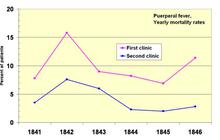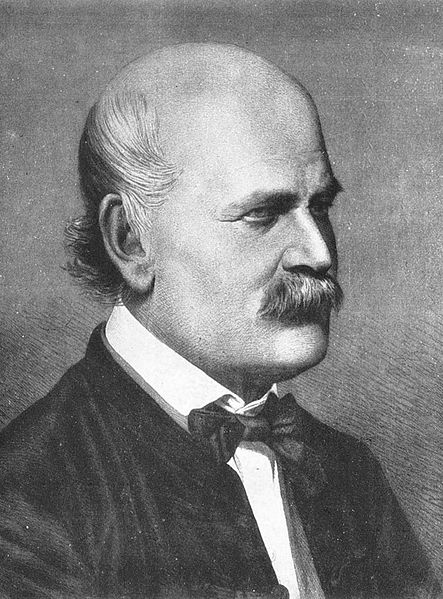 | ||||
Hand Washing & Prevention of Infectious Disease
History of Microbiology: Puerperal Fever & Dr. Ignaz Semmelweis
from Science Prof Online
Less than 200 years ago, people didn’t even know that germs existed, much less that clean hands help prevent the spread of disease. That connection had to be discovered. Dr. Ignaz Semmelweis was one of the key contributors to our understanding of infectious disease.
Who Was Ignaz Semmelweiss?
Ignaz Semmelweis was a Hungarian physician who
lived in the 1800s.
Article Summary: Most of us take for granted the knowledge that hand washing is essential for good personal hygiene. But this wasn't always the case.
Hand Washing & Infectious Disease
Puerperal fever mortality rates for the First (pink line = medical students) and Second (blue line = midwives) Clinic at the Vienna General Hospital 1841–1846.
 | ||||
You have free access to a large collection of materials used in a college-level introductory microbiology course. The Virtual Microbiology Classroom provides a wide range of free educational resources including PowerPoint Lectures, Study Guides, Review Questions and Practice Test Questions.
Page last updated: 4/2014
This article originally appeared on Suite101 online magazine.
SCIENCE PHOTOS
SPO VIRTUAL CLASSROOMS
 | ||||||
 | ||||||
SPO is a FREE science education website. Donations are key in helping us provide this resource with fewer ads.
Please help!
(This donation link uses PayPal on a secure connection.)
This was a period when science and medicine were still trying to banish the archaic belief in spontaneous generation; when Germ Theory (the understanding that infectious disease was caused by microbes) was still in its infancy.
Mysterious Post-partum Deaths
For part of Semmelweis’ career, he worked in a Viennese hospital where he observed that maternity patients were dying at an alarming rate. The doctor noticed that women who gave birth in the hospital wing where medical students were trained had a very high mortality rate; much higher than that of women in an adjoining hospital wing attended by midwives, and even higher than women who didn’t set foot in the hospital at all, but gave birth at home.
What was Killing New Mothers?
Like all medical students, the doctors-to-be at Vienna General Hospital dissected cadavers in anatomy class as part of their medical training. Most of the women dying after childbirth had been treated by student physicians who worked on cadavers before beginning their rounds in the maternity ward.
Autopsy and Childbirth Don’t Mix
Even though Germ Theory was not well known at the time, Semmelweis hypothesized that the medical students carried “cadaver particles” from autopsy into the delivery rooms, and that these particles caused the new mothers to become ill with, and frequently die from, puerperal fever.
Semmelweis began to require his medical student to wash their hands with chlorinated water (a solution used to eliminate the smell cadavers). His experiment was shown to be a success, when, the following year, mortality rates in the ward fell from over 18% to 1.3%.
Tragic End to an Illustrious Career
Even with this impressive data, Semmelweis was scorned and ridiculed by his peers for his strange ideas about hand washing, and was eventually forced to leave his post at the hospital.
Long after Dr. Semmelweis had been committed for depression and ultimately died of a Streptococcus infection (the same bacteria that caused puerperal fever), the idea of handwashing was accepted as a necessary component of public heath.
Procedure for Proper Hand Washing
To adequately wash your hands, the CDC recommends a technique of vigorous scrubbing with warm, soapy water for at least 20 seconds.
When using soap and water to wash your hands:
- Wet your hands with clean running water (warm water is best) and apply soap.
- Rub hands together to build a lather and then scrub all surfaces of your hands (fingertips and back of hands and between fingers are often forgotten).
- Continue rubbing hands for a full 20 seconds. No timer? Sing ‘Row, row, row your boat twice.
- Rinse hands well under running water
- Dry your hands with paper towel or an air dryer. It is best if you use paper towel to turn off the faucet
When using an alcohol-based hand sanitizer:
- Apply product to one of your palms
- Rub your hands together and continue rubbing the product over all surfaces of your hands and fingers until dry.




